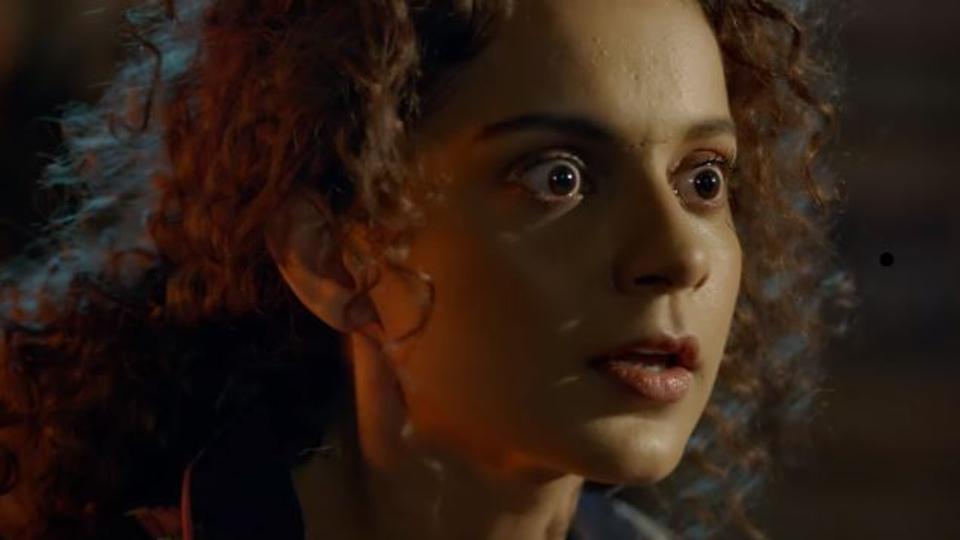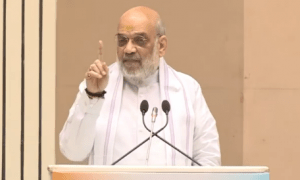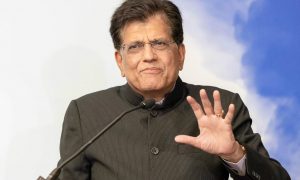Judgementall Hai KyaDirector – Prakash Kovelamudi
Cast – Rajkummar Rao, Kangana Ranaut, Jimmy Sheirgill, Amyra Dastur
Rating – 4/5
We first see her upside down but also right side up. When we meet Kangana Ranaut in Judgementall Hai Kya, we see her feet, mid-air and upside-down. They happen to be surrounded by framed pictures of Ranaut in outlandish, overdone costumes: as Pamela Anderson in the red Baywatch swimsuit, or wearing Angelina Jolie’s distinctive Maleficent horns. She’s doing yoga, a headstand against a wall-ful of photos she regularly gets taken, then photoshopped — much like Govinda used to put up pictures as a cop and a lawyer in Raja Babu.
Ranaut plays Bobby Grewal Batliwala in Judgementall Hai Kya, a half-Punjabi half-Parsi girl who grew up with the trauma of her parents death, and has since taken to folding paper boats and birds out of bad news, or, more specifically, the grisliest newspaper reports about domestic violence. She’s an impassioned dubbing artist who gets pictures taken imagining herself in roles she’s only voiced for local markets. While she is “comfortable” volunteering to spend months in a psychiatric facility, she doesn’t like her medication. This girl plays carrom with her Zoloft.
Bobby, as you may have gathered, is quite a character. The audience gets to know her alongside the childhood scarring she faced and is given a gradual awareness of her mental fragility, or else we would conveniently have called her ‘quirky.’ Later in Judgementall Hai Kya, a theatre director, ignorant of all her past and labels, marvels at her pluck: to him she’s simply a manic pixie dream girl. It makes me wonder if Bobby needed to be freer of our judgement, or, conversely, whether most manic-pixie heroines need medication.
Judgementall Hai Kya, directed by Prakash Kovelamudi and written by Kanika Dhillon, looks like a slick, snappy comedy but there is so much more to this smart, significant satire. This is a film about gaslighting, the relentless psychological manipulation intended to discredit people in order to nullify their version of events. It is about insensitively and eagerly labelling a condition instead of offering empathy. It is about trying to ‘handle,’ not help.
The treatment is delicious. Daniel B George, composer for Sriram Raghavan films like Johnny Gaddaar, keeps the vibe groovy, accentuating the changing moods while playfully misleading the audience. During a police investigation, his background score unmistakably borrows from Ray Manzarek’s keyboard solo from Riders On The Storm — a song with killers, roads, brains and toads, about fatal hitchhikers who may in fact be illusions. Nothing in this layered film is by accident.

Kangana Ranaut in a still from Judgementall Hai Kya.
If it were, cinematographer Pankaj Kumar would ensure the accidents look bloody good. There is a glorious shot of people painted orange and bleeding black I won’t soon forget, and Kumar, one of the finest directors of photography working today (Haider, Ship Of Theseus, Tumbbad) has wonkier and more subversive fun with this film as he plays up Bobby’s oversaturated world, and tinkers with frame-rate and contrast to depict her (and possibly our) mental states.
Judgementall Hai Kya wears the clothes of a murder-thriller. Nosy Dadar landlady Bobby develops a fixation on her tenant, convinced he’s out to commit a crime. Things take a fearful turn and Bobby is devastated: was she right all along, has she willed the situation to happen, or was she so desperate to prove her fixation that she took things into her own hands? Her tenant, Keshav, fibs about eating meat and smoking, but how can that damn him? As he plaintively reminds the policemen, everybody lies.
Rajkummar Rao plays Keshav with a placid smugness while the camera — taking on Bobby’s female-gaze — takes turns objectifying him and stepping away. He’s a calm man of few words, but the gifted actor makes dryness appear nasty. He gets under the skin, or maybe that’s what we are meant to feel, since he’s certainly captured Bobby’s imagination. Being brusque is no crime, of course — but then again, neither is Photoshop.

Rajkummar Rao in a still from Judgementall Hai Kya.
The narrative twists and coincidences are ambitious, and Kovelamudi weaves them together deftly, working the film both as thriller and allegory as the pace only intensifies. Judgementall Hai Kya has a lot to say, and not only via smart lines, though those are pointedly sharp. We’re informed Bobby suffers from acute psychosis, and later, when she’s seeing visions, one of her hallucinations calls another one ‘cute.’
Decidedly less cute is the sight of a cockroach. Ranaut spots one all over the place, dousing her house in pesticide and flinging slippers to squash it — this slipper hits a smiling Rao instead. As she loses grip on life to focus on a cockroach nobody else seems to see, it starts functioning as a symptom of her growing psychosis. Alternatively, though, could this tingling of her cockroach-sense signal an urgent itch she can’t scratch but she needs to?
Bobby believes this, as she calls bewildered policemen to tell them where she last saw the insect. The way Ranaut’s eyes gleam as she talks about the cockroach… this actress really is extraordinary. This is a finely acted film, with superb performances from Amrita Puri, Satish Kaushik and Jimmy Sheirgill, not to mention Rao, but it rests entirely on Ranaut’s shoulders and she delivers both vitality and credibility. Bobby may be over the top but hers is a sharply subtle performance, and Ranaut — not least because of the battles of perception she faces off-screen — is ideal for the part.

Kangana Ranaut and Rajkummar Rao in a still from Judgementall Hai Kya song Wakhra Swag.
At rehearsals for a newfangled production of the Ramayana (one where Dhillon cleverly takes on a wordy, self-referential cameo) Bobby stubbornly refuses to participate in a trust exercise. This is not a character who will trust — at least not on command.
Judgementall Hai Kya loses whizz in the final stretch, trying hard to keep audiences guessing even when the climax is apparent, and the makers could instead have concentrated on subtext. The investigative epiphanies, also, feel too simplistic compared to the messaging of the narrative and the film’s overall intelligence. I remain smitten, for instance, by the way they used the 1972 song Duniya Mein Logon Ko with such double-edged lyrical precision.
Watch this film. As evidenced by a man Bobby sees carrying homilies on placards on a street corner, Judgementall Hai Kya knows the difference between accepting and determining something. It is a film about malicious misdirection, and the validity of our narratives — especially those labelled incorrect. It’s okay to jump at a cockroach even if you’re the only one who sees it. From the right angle, a bug is a feature.




























 WhatsApp us
WhatsApp us